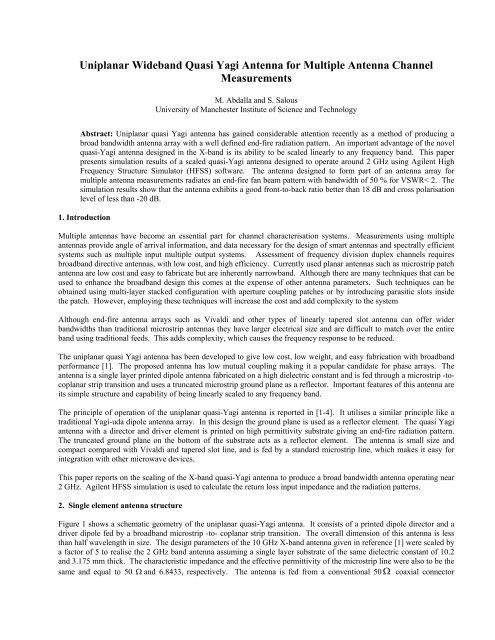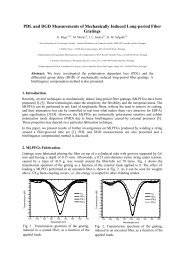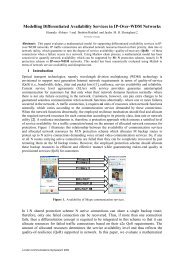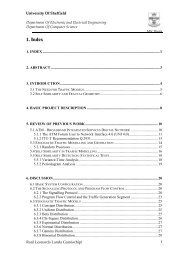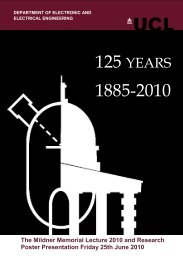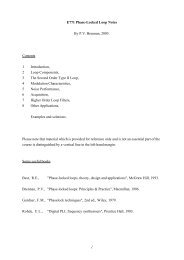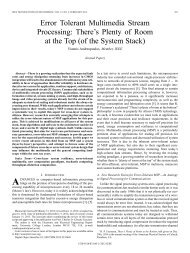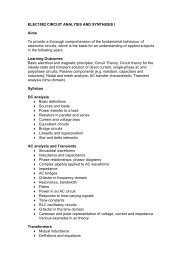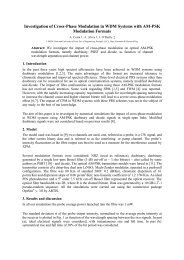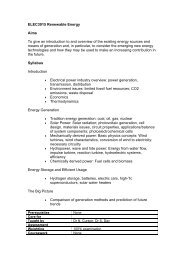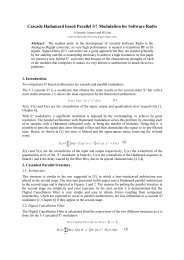Uniplanar Wideband Quasi Yagi Antenna for Multiple Antenna ...
Uniplanar Wideband Quasi Yagi Antenna for Multiple Antenna ...
Uniplanar Wideband Quasi Yagi Antenna for Multiple Antenna ...
You also want an ePaper? Increase the reach of your titles
YUMPU automatically turns print PDFs into web optimized ePapers that Google loves.
<strong>Uniplanar</strong> <strong>Wideband</strong> <strong>Quasi</strong> <strong>Yagi</strong> <strong>Antenna</strong> <strong>for</strong> <strong>Multiple</strong> <strong>Antenna</strong> Channel<br />
Measurements<br />
M. Abdalla and S. Salous<br />
University of Manchester Institute of Science and Technology<br />
Abstract: <strong>Uniplanar</strong> quasi <strong>Yagi</strong> antenna has gained considerable attention recently as a method of producing a<br />
broad bandwidth antenna array with a well defined end-fire radiation pattern. An important advantage of the novel<br />
quasi-<strong>Yagi</strong> antenna designed in the X-band is its ability to be scaled linearly to any frequency band. This paper<br />
presents simulation results of a scaled quasi-<strong>Yagi</strong> antenna designed to operate around 2 GHz using Agilent High<br />
Frequency Structure Simulator (HFSS) software. The antenna designed to <strong>for</strong>m part of an antenna array <strong>for</strong><br />
multiple antenna measurements radiates an end-fire fan beam pattern with bandwidth of 50 % <strong>for</strong> VSWR< 2. The<br />
simulation results show that the antenna exhibits a good front-to-back ratio better than 18 dB and cross polarisation<br />
level of less than -20 dB.<br />
1. Introduction<br />
<strong>Multiple</strong> antennas have become an essential part <strong>for</strong> channel characterisation systems. Measurements using multiple<br />
antennas provide angle of arrival in<strong>for</strong>mation, and data necessary <strong>for</strong> the design of smart antennas and spectrally efficient<br />
systems such as multiple input multiple output systems. Assessment of frequency division duplex channels requires<br />
broadband directive antennas, with low cost, and high efficiency. Currently used planar antennas such as microstrip patch<br />
antenna are low cost and easy to fabricate but are inherently narrowband. Although there are many techniques that can be<br />
used to enhance the broadband design this comes at the expense of other antenna parameters. Such techniques can be<br />
obtained using multi-layer stacked configuration with aperture coupling patches or by introducing parasitic slots inside<br />
the patch. However, employing these techniques will increase the cost and add complexity to the system<br />
Although end-fire antenna arrays such as Vivaldi and other types of linearly tapered slot antenna can offer wider<br />
bandwidths than traditional microstrip antennas they have larger electrical size and are difficult to match over the entire<br />
band using traditional feeds. This adds complexity, which causes the frequency response to be reduced.<br />
The uniplanar quasi <strong>Yagi</strong> antenna has been developed to give low cost, low weight, and easy fabrication with broadband<br />
per<strong>for</strong>mance [1]. The proposed antenna has low mutual coupling making it a popular candidate <strong>for</strong> phase arrays. The<br />
antenna is a single layer printed dipole antenna fabricated on a high dielectric constant and is fed through a microstrip -tocoplanar<br />
strip transition and uses a truncated microstrip ground plane as a reflector. Important features of this antenna are<br />
its simple structure and capability of being linearly scaled to any frequency band.<br />
The principle of operation of the uniplanar quasi-<strong>Yagi</strong> antenna is reported in [1-4]. It utilises a similar principle like a<br />
traditional <strong>Yagi</strong>-uda dipole antenna array. In this design the ground plane is used as a reflector element. The quasi <strong>Yagi</strong><br />
antenna with a director and driver element is printed on high permittivity substrate giving an end-fire radiation pattern.<br />
The truncated ground plane on the bottom of the substrate acts as a reflector element. The antenna is small size and<br />
compact compared with Vivaldi and tapered slot line, and is fed by a standard microstrip line, which makes it easy <strong>for</strong><br />
integration with other microwave devices.<br />
This paper reports on the scaling of the X-band quasi-<strong>Yagi</strong> antenna to produce a broad bandwidth antenna operating near<br />
2 GHz. Agilent HFSS simulation is used to calculate the return loss input impedance and the radiation patterns.<br />
2. Single element antenna structure<br />
Figure 1 shows a schematic geometry of the uniplanar quasi-<strong>Yagi</strong> antenna. It consists of a printed dipole director and a<br />
driver dipole fed by a broadband microstrip -to- coplanar strip transition. The overall dimension of this antenna is less<br />
than half wavelength in size. The design parameters of the 10 GHz X-band antenna given in reference [1] were scaled by<br />
a factor of 5 to realise the 2 GHz band antenna assuming a single layer substrate of the same dielectric constant of 10.2<br />
and 3.175 mm thick. The characteristic impedance and the effective permittivity of the microstrip line were also to be the<br />
same and equal to 50 Ω and 6.8433, respectively. The antenna is fed from a conventional 50 Ω coaxial connector
through broadband microstrip -to- coplanar strip transition. The dimensions of the proposed antenna are as follows (unit<br />
in mm): W 1 = W 3 = W 4 = W 5 = W dri = W dir =3, W 2 = 6, W 6 = S 5 = S 6 = 1.5, L 1 = 16.5, L 2 = L 5 = 7.5, L 3 = 24, L 4 = 9, S ref =<br />
19.5, S dir = 15, S sub = 7.5, L dri = 43.5 and L dir = 16.5.<br />
Figure 1 Schematic drawing of <strong>Uniplanar</strong> <strong>Quasi</strong> <strong>Yagi</strong> antenna [1]<br />
3. Simulation Results and Discussion<br />
The analysis and design procedure is based on the full-wave electromagnetic solver based on Agilent HFSS simulator.<br />
The calculated (simulated) results <strong>for</strong> input return loss (amplitude and phase) against frequency are shown in Figure 2.<br />
From the figure we notice the antenna provides a broad bandwidth of about 50 % <strong>for</strong> VSWR < 2. The antenna is well<br />
matched and has a gain of about 5 dB over more than 50 % bandwidth (1.6 to 2.6 GHz). Figure 3 shows the calculated<br />
input impedance of this broadband antenna. Figure 3.b shows that the variations are less than 1 Ω over 1.6-2.6 GHz.<br />
Figure 4 shows the calculated far field radiation pattern in the E and H-plane including the co-polarization and crosspolarization<br />
at 2 GHz. The radiation pattern indicates a well-defined end fire with front to back ratio of more than 18 dB<br />
and cross polarisation level of better than -20 dB. The simulated results of the antenna radiation pattern showed that the<br />
radiation pattern is well stable over the operating band.<br />
A single antenna was realised and its characteristics were evaluated using a network analyser. The measurements were<br />
consistent with those of figures 2 and 3.<br />
(a)<br />
(b)<br />
Figure 2. Agilent HFSS simulation <strong>for</strong> input return loss (a) magnitude, (b) phase
(a)<br />
(b)<br />
Figure 3. (a) Locus of antenna impedance (b) Variation of input impedance as a function of frequency<br />
(a)<br />
(b)<br />
Figure 4. Calculated radiation pattern at 2-GHz (a) E-Plane, (b) H-Plane. Co-polarisation, Cross-polarisation.<br />
4. Application of <strong>Quasi</strong> <strong>Yagi</strong> <strong>Antenna</strong> in UMIST Channel Sounder <strong>for</strong> Angle of Arrival Estimation<br />
For several years UMIST has been carrying a program of research into characterisation of the mobile radio channel at 2<br />
GHz. Recently, the dual band channel sounder was upgraded to an 8-channel parallel receiver [5]. At present the sounder<br />
has six antennas, which are used to estimate the angle of arrival in the azimuth plane. The advantages of quasi <strong>Yagi</strong><br />
antennas in terms of broad bandwidth low profile, end fire antenna, low mutual coupling makes it a popular candidate <strong>for</strong><br />
phased antenna array that is suitable <strong>for</strong> mobile application.<br />
As far as azimuth plane is concerned a number of antenna array configurations such as linear and circular have been<br />
considered. It was decided to use the circular uni<strong>for</strong>m beam array (CUBA) geometry in the estimation of the angle of<br />
arrival. In order to enhance the angular resolution of the sounder an array of eight antenna elements will be used to cover<br />
360-degree azimuth with 45 degrees interval. Current work is concerned with steering the antenna beam using electronic<br />
phase shifter in three positions resulting in 24-beams <strong>for</strong> eight antenna elements.
5. Conclusion<br />
A <strong>Uniplanar</strong> quasi-<strong>Yagi</strong> wideband antenna operating near 2 GHz realised on a thick substrate and high dielectric constant<br />
is successfully demonstrated using Agilent HFSS simulation. The antenna has a simple structure, compact and easy to<br />
fabricate. It provides a well-defined end-fire antenna, which makes it well suited <strong>for</strong> use in base stations of wireless<br />
communication systems, electronically steering phased arrays and power combining application.<br />
References<br />
[1] Kaneda. N., Qian.Y., and Itoh. T., "A novel <strong>Yagi</strong>-Uda dipole array fed by a microstrip-to CPS transition", Asia Pacific<br />
Microwave Conf.Dig., December 1998, pp.1413-1416.<br />
[2] Yongxi Qian W. R. Deal, Koriaki Kaneda and Tatsuo Itoh, "A <strong>Uniplanar</strong> <strong>Quasi</strong>-<strong>Yagi</strong> <strong>Antenna</strong> with Wide Bandwidth<br />
and Low Mutual Coupling Characteristics”, IEEE 1999 AP-S Int. Symp.Dig., July 1999, pp.924-927.<br />
[3] Y. Qian W. R. Deal, N. Kaneda and T. Itoh "A broadband uniplanar microstrip-to-CPS transition", 1997 Asia Pacific<br />
Microwave Conf.Dig., Dec.1997, pp.609-612.<br />
[4] Y. Qian, W.R. Deal, N. Kaneda and Itoh "Microstrip-fed quasi-<strong>Yagi</strong> antenna with broadband characteristics",<br />
Electronic Letters, vol 34, No 23, November 1998, pp. 2194-2196.<br />
[5] S. Salous, P. Fillipidis, and I. Hawkins, "<strong>Multiple</strong> antenna channel sounder using a parallel receiver architecture",<br />
SCI2002, Orlando Florida, July 2002.


